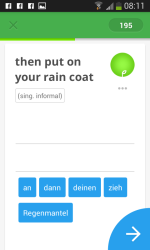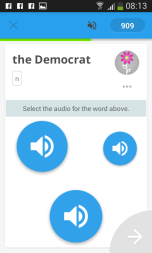Ok, let’s be honest here. This post is about teacher training, but ‘development’ sounds more respectful, more humane, more modern. Teacher development (self-initiated, self-evaluated, collaborative and holistic) could be adaptive, but it’s unlikely that anyone will want to spend the money on developing an adaptive teacher development platform any time soon. Teacher training (top-down, pre-determined syllabus and externally evaluated) is another matter. If you’re not too clear about this distinction, see Penny Ur’s article in The Language Teacher.
 The main point of adaptive learning tools is to facilitate differentiated instruction. They are, as Pearson’s latest infomercial booklet describes them, ‘educational technologies that can respond to a student’s interactions in real-time by automatically providing the student with individual support’. Differentiation or personalization (or whatever you call it) is, as I’ve written before , the declared goal of almost everyone in educational power these days. What exactly it is may be open to question (see Michael Feldstein’s excellent article), as may be the question of whether or not it is actually such a desideratum (see, for example, this article ). But, for the sake of argument, let’s agree that it’s mostly better than one-size-fits-all.
The main point of adaptive learning tools is to facilitate differentiated instruction. They are, as Pearson’s latest infomercial booklet describes them, ‘educational technologies that can respond to a student’s interactions in real-time by automatically providing the student with individual support’. Differentiation or personalization (or whatever you call it) is, as I’ve written before , the declared goal of almost everyone in educational power these days. What exactly it is may be open to question (see Michael Feldstein’s excellent article), as may be the question of whether or not it is actually such a desideratum (see, for example, this article ). But, for the sake of argument, let’s agree that it’s mostly better than one-size-fits-all.
Teachers around the world are being encouraged to adopt a differentiated approach with their students, and they are being encouraged to use technology to do so. It is technology that can help create ‘robust personalized learning environments’ (says the White House) . Differentiation for language learners could be facilitated by ‘social networking systems, podcasts, wikis, blogs, encyclopedias, online dictionaries, webinars, online English courses,’ etc. (see Alexandra Chistyakova’s post on eltdiary ).
But here’s the crux. If we want teachers to adopt a differentiated approach, they really need to have experienced it themselves in their training. An interesting post on edweek sums this up: If professional development is supposed to lead to better pedagogy that will improve student learning AND we are all in agreement that modeling behaviors is the best way to show people how to do something, THEN why not ensure all professional learning opportunities exhibit the qualities we want classroom teachers to have?
Differentiated teacher development / training is rare. According to the Center for Public Education’s Teaching the Teachers report , almost all teachers participate in ‘professional development’ (PD) throughout the year. However, a majority of those teachers find the PD in which they participate ineffective. Typically, the development is characterised by ‘drive-by’ workshops, one-size-fits-all presentations, ‘been there, done that’ topics, little or no modelling of what is being taught, a focus on rotating fads and a lack of follow-up. This report is not specifically about English language teachers, but it will resonate with many who are working in English language teaching around the world.
The promotion of differentiated teacher development is gaining traction: see here or here , for example, or read Cindy A. Strickland’s ‘Professional Development for Differentiating Instruction’.
Remember, though, that it’s really training, rather than development, that we’re talking about. After all, if one of the objectives is to equip teachers with a skills set that will enable them to become more effective instructors of differentiated learning, this is most definitely ‘training’ (notice the transitivity of the verbs ‘enable’ and ‘equip’!). In this context, a necessary starting point will be some sort of ‘knowledge graph’ (which I’ve written about here ). For language teachers, these already exist, including the European Profiling Grid , the Eaquals Framework for Language Teacher Training and Development, the Cambridge English Teaching Framework and the British Council’s Continuing Professional Development Framework (CPD) for Teachers . We can expect these to become more refined and more granularised, and a partial move in this direction is the Cambridge English Digital Framework for Teachers . Once a knowledge graph is in place, the next step will be to tag particular pieces of teacher training content (e.g. webinars, tasks, readings, etc.) to locations in the framework that is being used. It would not be too complicated to engineer dynamic frameworks which could be adapted to individual or institutional needs.
This process will be facilitated by the fact that teacher training content is already being increasingly granularised. Whether it’s an MA in TESOL or a shorter, more practically oriented course, things are getting more and more bite-sized, with credits being awarded to these short bites, as course providers face stiffer competition and respond to market demands.
 Classroom practice could also form part of such an adaptive system. One tool that could be deployed would be Visible Classroom , an automated system for providing real-time evaluative feedback for teachers. There is an ‘online dashboard providing teachers with visual information about their teaching for each lesson in real-time. This includes proportion of teacher talk to student talk, number and type of questions, and their talking speed.’ John Hattie, who is behind this project, says that teachers ‘account for about 30% of the variance in student achievement and [are] the largest influence outside of individual student effort.’ Teacher development with a tool like Visible Classroom is ultimately all about measuring teacher performance (against a set of best-practice benchmarks identified by Hattie’s research) in order to improve the learning outcomes of the students.
Classroom practice could also form part of such an adaptive system. One tool that could be deployed would be Visible Classroom , an automated system for providing real-time evaluative feedback for teachers. There is an ‘online dashboard providing teachers with visual information about their teaching for each lesson in real-time. This includes proportion of teacher talk to student talk, number and type of questions, and their talking speed.’ John Hattie, who is behind this project, says that teachers ‘account for about 30% of the variance in student achievement and [are] the largest influence outside of individual student effort.’ Teacher development with a tool like Visible Classroom is ultimately all about measuring teacher performance (against a set of best-practice benchmarks identified by Hattie’s research) in order to improve the learning outcomes of the students.
You may have noticed the direction in which this part of this blog post is going. I began by talking about social networking systems, podcasts, wikis, blogs and so on, and just now I’ve mentioned the summative, credit-bearing possibilities of an adaptive teacher development training programme. It’s a tension that is difficult to resolve. There’s always a paradox in telling anyone that they are going to embark on a self-directed course of professional development. Whoever pays the piper calls the tune and, if an institution decides that it is worth investing significant amounts of money in teacher development, they will want a return for their money. The need for truly personalised teacher development is likely to be overridden by the more pressing need for accountability, which, in turn, typically presupposes pre-determined course outcomes, which can be measured in some way … so that quality (and cost-effectiveness and so on) can be evaluated.
Finally, it’s worth asking if language teaching (any more than language learning) can be broken down into small parts that can be synthesized later into a meaningful and valuable whole. Certainly, there are some aspects of language teaching (such as the ability to use a dashboard on an LMS) which lend themselves to granularisation. But there’s a real danger of losing sight of the forest of teaching if we focus on the individual trees that can be studied and measured.






 The trouble with all of this is that it can only work for a certain time and, for some people, never. There’s always going to be someone like me who can put in a couple of hours a day more than you can. Or someone, in my case, like ‘Nguyenduyha’, who must be doing about four hours a day, and who, I know, is out of my league. I can’t compete and the realisation slowly dawns that my life would be immeasurably sadder if I tried to.
The trouble with all of this is that it can only work for a certain time and, for some people, never. There’s always going to be someone like me who can put in a couple of hours a day more than you can. Or someone, in my case, like ‘Nguyenduyha’, who must be doing about four hours a day, and who, I know, is out of my league. I can’t compete and the realisation slowly dawns that my life would be immeasurably sadder if I tried to.